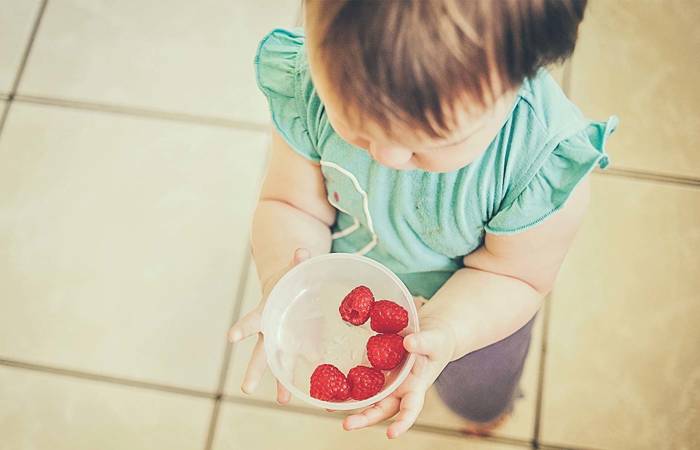Like what you see?
Sign up to receive more free parenting advice.
Thank you for subscribing to our newsletter!
Child Development

iStock: AnVr
Australian babies have the highest incidence of food allergies in the world, so how can parents manage the risks they face, both at home and at childcare?
Australian babies have the highest incidence of food allergies compared to the rest of the world.
Researchers found that more than ten per cent of Australian infants are diagnosed with a food-related allergy by the time they turn one.
“There has been a rapid increase of under four-year-olds presenting to emergency with anaphylaxis with food as the trigger,” explains Sally Voukelatos, Health Educator at Allergy & Anaphylaxis Australia (A&AA).
“The most common food allergies are cow’s milk (dairy), egg and peanut. About 80 per cent of children will grow out of milk and egg allergies during school-age.”
“While only about 20 per cent will grow out of peanut, tree nut, sesame, fish and shellfish allergies.”
An allergic reaction is when a substance such as food, pollen, pets, house dust mite, insects, and some medicines, triggers an immune response, while an intolerance or food sensitivity usually presents with gut related symptoms such as nausea, vomiting or constipation and does not involve the immune system.
A food allergy, which can be life-threatening, can be tested through a skin-prick or blood test, however, information on what happened when the person ate the food is also important in making the diagnosis. There is no test available for a food intolerance.
Signs and symptoms of allergic reactions
Voukelatos explains that signs and symptoms of an allergic reaction can vary in severity.
Mild to moderate signs and symptoms can include swelling of the lips, face and eyes, hives or welts, a tingling mouth, stomach pain and vomiting. Note that stomach pain and vomiting are signs of anaphylaxis for insect allergy.
A severe reaction (anaphylaxis) can either affect the breathing (respiratory) and/or heart and blood vessels (cardiovascular) system.
“In terms of respiratory reactions, people can have difficulty breathing, present with a swollen tongue which can block their airway, tightness or swelling of the throat, a hoarse voice, a wheeze or a persistent cough,” she says.
“When it comes to the cardiovascular system, blood pressure can be affected, which can cause persistent dizziness or in severe cases, collapse.
“For young children, they can become pale and floppy.”
Anaphylaxis is a severe allergic reaction and can be life threatening.
“People at higher risk of anaphylaxis are prescribed an adrenaline injector and should have an ASCIA Action Plan for Anaphylaxis, which is an emergency response plan that outlines the steps to follow in the event of an allergic reaction, including anaphylaxis,” Voukelatos adds.
“Some people can be allergic to food but, because their reactions have been mild or moderate, they aren’t prescribed an adrenaline injector. These people can still be at risk of anaphylaxis, but they are at lower risk.”
Strategies to managing allergies at home
After a medical diagnosis, Voukelatos suggests families consider how they will best manage the allergen/s in their home.
For some, they will decide to remove it. For example, if the trigger is peanuts or tree nuts, they can be more easily removed than other allergens.
“It can be difficult when the food allergen is a staple food item like milk, egg or wheat,” she adds.
“Many families will still have those food in the kitchen, but they need to put steps in place to avoid the child accidentally eating them.”
She recommends the following strategies for families:
- Store the allergen on high shelves to be out of reach for young children.
- Use hot soapy water for a clean working environment and to avoid cross contamination.
- Use disposable paper towels to wipe surfaces to avoid contaminating the sponge or dishcloth.
- As equipment can be harder to clean, consider having separate appliances, for example, a separate, labelled toaster for children with wheat allergies.
- Use sealed labelled containers for foods containing allergens.
- Use a labelled basket in the fridge or pantry for foods that are safe for the person with food allergy. It’s advised to store these up high to avoid allergen foods spilling into the basket.
- Use separate oil for cooking food for the person with an allergy, as food cooked in the same oil becomes contaminated.
Strategies for starting childcare
“Handing over your child to an early education centre can be very stressful for parents,” Voukelatos highlights.
“Childcare is so important for a child’s socialisation and allergies shouldn’t be a barrier for children being able to participate in early learning.”
She recommends that, before starting childcare, parents meet with the centre and understand what training staff have in anaphylaxis management (there is free online anaphylaxis training that should be updated every two years), whether they have a general use adrenaline injector in their first aid kit, whether they have policies and procedures around anaphylaxis management and how they manage the onsite catering and food preparation (free online training for staff that prepare, serve and supervise food in childcare is also available).
“Parents need to provide an ASCIA Action Plan and at least one of their prescribed adrenaline injectors,” Voukelatos adds.
Parents should work with staff to develop an individualised anaphylaxis care plan that includes risk minimisation strategies.
“You’ll never be able to have a zero-risk environment, but by identifying the risk, parents and childcare staff can work together to put strategies in place to minimise those risks,” she notes.
Potential risks and management strategies to consider:
- All children should wash their hands before eating as part of good hygiene but particularly if there is a child with a food allergy.
- Enough staff supervision during meals, particularly for younger children, to monitor that children aren’t sharing food or drinks.
- Discuss with the centre about the option for the parent to provide meals and snacks, particularly for children with multiple allergies. These should be clearly labelled with the child’s name.
- For the child with food allergy to use easily identifiable bowls, plates, cups and cutlery, so they can be reassured they are eating their allocated meal.
- For very young children, they may need their own highchair due to spills, smears and the difficulty in cleaning.
- For food-based activities, staff and parents need to communicate to find the best approach to safely include the child in the activity.
- Sunscreens and moisturisers (including nappy cream) to be free from food-based ingredients (like nut oil, goat’s milk or oats) and if unavailable in the centre, for parents to provide their own.
- Parents can suggest the centre sends information on food allergy in the newsletter for the centre’s community, so they are aware someone at the centre has a food allergy.
- Staff can educate the child’s peers in an age-appropriate way about the risks of sharing food.
“It’s about parents having confidence in the childcare staff to reduce the risks and, if needed, to be able to manage an allergic reaction,” adds Voukelatos.
“AA&A have a comprehensive list of risk minimisation strategies parents and childcare centres can also refer to.
“The Allergy Aware website provides many resources, including the Best Practice Guidelines , to support children’s education and care services to prevent and manage anaphylaxis.
“A&AA qualified health educators can be contacted on our 1300 728 000 helpline, to provide information, support and resources.”







